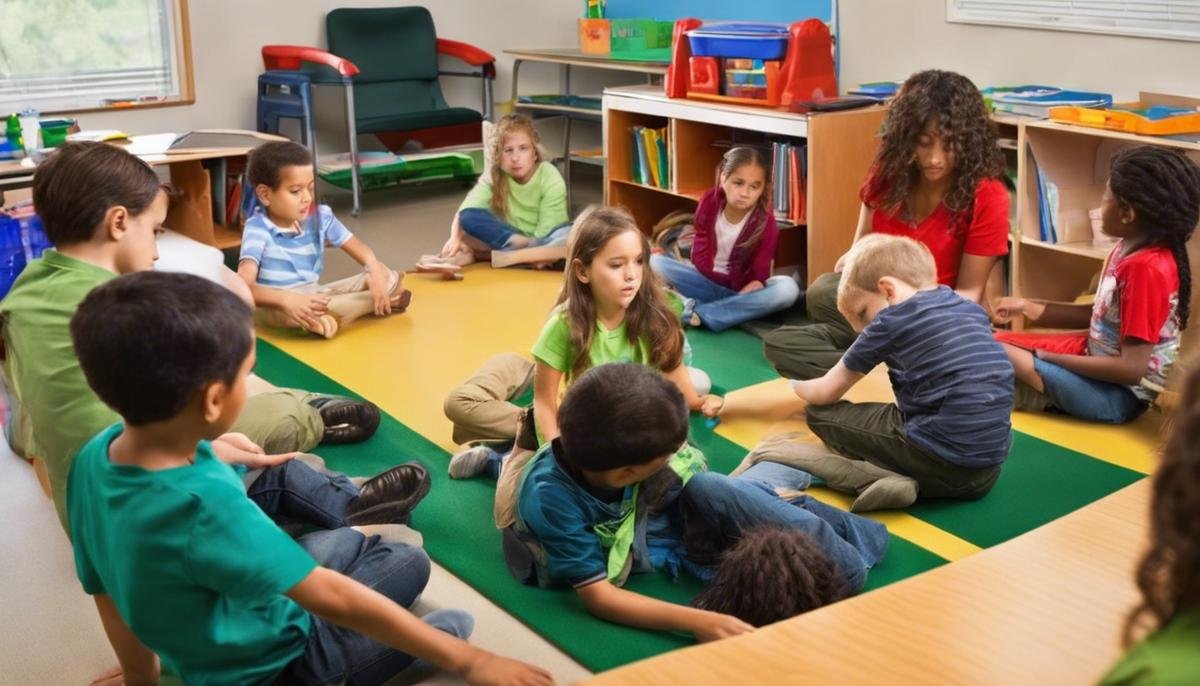
When we send our children off to school each morning, there’s a shared expectation that they will enter a space that is not only conducive to learning but also to their overall safety. However, for autistic children, the school environment holds unique challenges and complexities that demand our keen attention and understanding. These students encounter a world that may often be improperly attuned to their sensory, communication, and structural needs. Addressing these aspects is not only crucial for their wellbeing but is integral to their ability to thrive academically and socially. It falls upon educators, administrators, and the entire school community to ensure that schooling is inclusive and safe for every child, recognizing autism’s spectrum and the diverse support it necessitates. This essay seeks to shed light on the nuanced safety considerations required for autistic children in educational settings and the collaborative efforts needed to foster an environment in which they can flourish securely.
Understanding Autism and Safety Needs
Title:Understanding and Prioritizing School Safety for Our Kids With Autism
While we’re bustling in our kitchens, crafting meal plans, and checking off our seemingly endless to-do lists, let’s take a moment to talk about something close to our hearts—our children’s safety at school, and in particular, for those unique little souls in our lives who are on the autism spectrum. School safety for children with autism isn’t just a matter of security; it’s about understanding, accommodation, and the right measure of support.
First and foremost, communication is key. Children with autism may experience challenges in expressing their needs and concerns. Traditional safety drills and loud alarms designed to keep students safe can sometimes do the opposite for our sensory-sensitive kiddos, causing undue stress or even panic. Schools with a nuanced approach to safety can offer personalized plans for students with autism, ensuring they understand what’s happening and feel secure through any situation.
Moving on, let’s consider sensory sensitivities. The bustling hallways, loud cafeterias, and even the fluorescent lights buzzing overhead can be overwhelming. A school environment that considers these sensory triggers and provides quiet, safe havens where children with autism can retreat when overstimulated prioritizes their emotional and physical safety, making the school experience more positive and less daunting.
Inclusion is another puzzle piece of the safe school environment for children with autism. It’s not just about having them in the same classrooms; it’s about fostering a culture of understanding among all students and staff. When children with and without autism learn side by side about kindness, respect, and patience, everyone thrives, and the school becomes a community where no one feels left out or misunderstood.
Now, let’s chat about transitioning, a part of the day that might seem insignificant but can feel like a high-stake change to a child with autism. Schools that ease these transitions—be it changing classrooms, switching activities, or moving from school to home—help minimize stress and confusion, ensuring that children with autism feel just as safe during these times as they do in the structured environment of their regular classrooms.
Consistency and routine are cornerstones of feeling secure for many children with autism. A school that maintains consistent routines and clear expectations helps these students navigate their day with confidence. Isn’t it reassuring when you know just what’s coming up next? It’s even more so for children on the spectrum.
Emergency preparedness is a non-negotiable aspect of safety. Children with autism might need more time to process information and react, so individual emergency plans and training tailored to their abilities and understanding are essential. This helps avoid any added confusion or stress in an already tense situation.
Last but not least, let’s not forget the dedicated educators and staff. Training in autism awareness and intervention strategies is incredibly crucial. A well-informed teacher or aide can be the difference between a child feeling safe or threatened in new or unpredictable situations.
In the whirlwind of life, where family, work, and homemaking intertwine, school safety remains a paramount concern, more so for our children with autism, who perceive the world in their beautiful, unique way. It’s about crafting an environment that adapts to their needs, just as they stretch and grow to meet the world. With thoughtful consideration and a few adjustments, schools can be safe havens that understand and celebrate the differences in every child. Let’s continue to advocate for these necessary changes because every child, especially those with autism, deserves to feel safe and valued in their school community.

Communication Strategies for Safety
Creating a Secure Haven: Communication as the Keystone for Autistic Children’s Safety in School
When we picture a school, we imagine it as a place where our kids grow, learn, and play in safety. For autistic children, making that picture a reality takes a little more finesse, a touch of empathy, and a whole lot of communication. Here’s how effective communication breaks down barriers and builds up security for these special students.
Think of school as a bustling city—it’s easy to get lost in the crowd without proper signposts. Clear communication acts like those signposts for autistic children. With verbal and non-verbal cues taking different forms, staff should be attuned to understanding each child’s way of expression. A thumbs-up might mean “All good” for one child, while another might show a drawing to indicate feeling safe. It’s about learning their language.
Teacher-parent collaboration is a cornerstone of safety. Information shared about a child’s behavior patterns, triggers, and calming strategies empowers educators to be proactive rather than reactive. It’s like sending them into school with an invisible shield — they’ve got backup. This open line also alerts teachers to any changes in the home environment that might affect the child’s school day.
A key tool in this communication arsenal is the use of visual aids. Schedules, charts, and pictures are familiar friends to many autistic children. They rely on these tools to navigate their day with predictability and comfort. These visuals should be consistent across home and school settings, ensuring a seamless transition and providing a familiar touchstone in stressful situations.
Utilizing technology can be a game-changer, too. Apps designed for non-verbal communication can break down barriers and give children the power to express their needs and concerns. Imagine a child who struggles with speech being able to tap a few buttons and show a picture of what’s bothering them. It’s empowerment in the palm of their hands.
Peer-to-peer communication is equally important. Creating buddy systems and peer education programs can cultivate a nurturing environment while also promoting inclusiveness. When classmates understand each other’s differences, they can become advocates for safety and support within the school’s microcosm.
With the rise of social media and online communities, harnessing these platforms for training and awareness elevates the whole conversation on a macro level. It invites parents, educators, and students into a larger dialogue about accommodating and safeguarding autistic children—a testament to the power of collective responsibility and care.
In essence, while the bricks and mortar of the school buildings are solid, it’s the soft skills of communication that truly fortify the walls of safety around autistic children. Effective communication is not just about speaking clearly; it’s about listening with intention, interpreting with care, and reacting with knowledge. It’s the silent sentry that stands guard, ensuring a secure and nurturing haven for these children to thrive academically, socially, and emotionally. After all, a safe learning environment is a right, not a privilege, and it’s through thoughtful, tailored communication that this can be achieved.

Environmental Adaptations for Increased Security
Empowering Autistic Students: Environmental Adaptations for Enhanced School Safety
Navigating the bustling hallways and loud cafeterias of a school can be a source of concern for parents of autistic children. Creating a safe and supportive school environment is more than just the physical space; it’s about cultivating an atmosphere that addresses unique challenges and affirms the well-being of those with autism. Here are some practical changes schools can embrace to bolster safety and comfort for autistic students.
Designating Quiet Zones: Schools should consider establishing quiet areas or rooms where autistic students can retreat to decompress when overwhelmed. Such spaces are essential for students who might experience sensory overload, providing a tranquil haven that can help in regulating emotions and reducing anxiety.
Visual Schedules and Signage: Accessible and predictable schedules are key for autistic students. Posting visual schedules around the school and within classrooms aids in reinforcing consistency. Additionally, clear and simple signage throughout the school can assist students in navigating their way without unnecessary stress.
Structured Social Interaction Opportunities: While inclusive, unstructured play is beneficial, setting up structured social interactions can offer a controlled environment for autistic students to practice social skills. These can range from organized lunchtime social groups to specific peer-mentoring programs, providing a framework for positive, guided interaction.
Professional Development on Non-Verbal Cues: Educators and school staff benefit from training that helps them interpret and respond to non-verbal cues. Recognizing the nuances in body language, facial expressions, and other indicators can improve the way teachers interact with and support autistic students.
Building a Predictable Environment: Beyond clinging to a strict daily routine, schools can bolster safety by ensuring that any environmental changes are predictable. Whether it’s a fire drill, assembly, or school event, giving advanced notice and clear information about what to expect can help autistic students prepare mentally and emotionally for changes in their regular schedule.
Modified Learning Materials: Schools can further support autistic students by customizing learning materials and methods. Items such as weighted lap pads or fidget tools can help students self-regulate during class. Additionally, schools should offer alternative seating options, like standing desks or bean bags, that cater to various sensory needs.
Bullying Prevention Policies: Autistic students often face a higher risk of bullying. Schools need to establish clear prevention policies and foster an environment of acceptance and respect. Anti-bullying campaigns that involve the whole school community can promote understanding and protect the safety and mental health of all students.
Cross-Functional Safety Teams: Bringing together teachers, administrators, special education professionals, and parents, cross-functional teams can focus on developing comprehensive strategies to improve safety for autistic students. These teams can address school-wide policies, individual student needs, and emergency protocols tailored to the autistic community.
By embracing these environmental changes, schools can transform into places where autistic students feel understood, supported, and above all, safe. Behind every strategy lies the ultimate goal: to empower every child to thrive in a learning environment that celebrates their individuality and ensures their security. Let’s not just accommodate our autistic students; let’s make them feel cherished in every corner of their educational journey.

Building a Safety Culture at School
Creating a Supportive School Network: Every Child Deserves a Champion
In a world that’s wonderfully diverse, schools have the crucial role of being sanctuaries for every child, including those on the autism spectrum. But how can schools become beacons of safety, not just in theory but in practice?
First and foremost, it begins by establishing a supportive network within the school, which acts like a safety net for autistic children. Teachers, aides, and counselors must be interconnected, sharing insights and updates on each child’s progress and well-being. It shouldn’t just stop there; this network needs to extend its threads to the cafeteria staff, librarians, bus drivers, and even crossing guards – anyone who has a touchpoint with the child during their school day.
Next, we must turn our attention to the playground, the epitome of unstructured social chaos that can be overwhelming for many autistic children. By integrating structured play options and identifying buddies who can engage with these children during recess, schools can mitigate the potential for stress and social isolation. Add to this designated supervised areas that are known safe havens, and we create a comfort zone in the sea of schoolyard energy.
Peer education is another potent tool. Educating all children about autism promotes empathy and understanding. By fostering a buddy system where neurotypical students are paired with autistic peers during select school activities, genuine friendships are forged, and support becomes part of the school’s social fabric.
Tailored Behavior Support Plans (BSPs) that are meticulously laid out can make a world of difference. A well-constructed BSP provides everyone – the child, the staff, and the parents – with guidelines for managing and understanding behaviors that might otherwise be misinterpreted. It also means taking appropriate steps to de-escalate stressful situations in a manner that’s tailored to the individual child.
Accessibility is yet another crucial factor. School facilities need to be assessed and adapted to cater to the physical needs of autistic students. From wheelchair ramps to noise-cancelling headphones in the library, small changes can have a big impact on a child’s ability to navigate their school environment with confidence.
Lastly, let’s not forget about the power of recognition – celebrating small victories and acknowledging the efforts of autistic students can reinforce their sense of belonging. Whether it’s an art project displayed on the wall or a part in the school play, recognizing each child’s contribution to the school community underscores that they are valued and important.
In conclusion, building a culture that prioritizes the safety and well-being of autistic children doesn’t hinge on a single action – it’s a tapestry woven from the threads of empathy, understanding, preparedness, and action. It requires a collaborative, ongoing effort that champions the potential of every student. When schools embrace this challenge, they do more than educate; they transform lives, one day at a time.

Emergency Preparedness and Response
Preparing Schools for Emergencies: Safeguarding Our Autistic Children
School emergencies can happen any time, anywhere. When they do, it’s crucial that schools have solid plans in place to protect all students, especially those with special needs like autism. Schools can better prepare for such situations by extending beyond the foundational measures already discussed. As members of a vibrant family community, let’s explore additional ways we can ensure our schools are nurturing, secure, and responsive environments for children on the spectrum during emergencies.
Specialized Emergency DrillsTraditional emergency drills are often based on the assumption that all students will respond similarly. However, autistic children can react differently to stress and disturbance. Tailored drills that take into consideration the unique needs of these students can help them understand what to expect and how to respond. By simulating various scenarios, including unforeseen changes and disruptions, schools can give autistic students the tools they need to remain calm and secure.
Empowering Self-AdvocacyTeaching autistic children about their own safety needs and how to express them can be empowering. With self-advocacy, they develop the ability to communicate specific issues they face during an emergency. Role-play scenarios and social stories can be excellent tools to help students understand and verbalize their needs in high-stress situations.
Regular Parent-Staff CommunicationThe ongoing dialogue between parents and school staff is integral. Parents have intimate knowledge of their child’s needs and can provide the school with valuable insights, which can shape more nuanced emergency protocols. Monthly check-ins and updates can ensure that all individualized plans remain relevant and effective for each child.
Partnering with Emergency RespondersAnother key component in preparing schools for emergencies is ensuring local emergency responders are familiar with the student body’s needs. Workshops and meetings that include first responders can be instrumental in educating them on how best to assist autistic children. Together, they can formulate strategies that address communication barriers and behavioral responses unique to these students during crises.
Safe SpacesHaving designated safe spaces that are familiar and comforting to autistic children can provide a refuge during emergencies. These spaces should be known to the child prior to any emergency and equipped with items that can minimize stress, like noise-canceling headphones or fidget toys.
Open Communication ChannelsIn the midst of an emergency, clear and open channels of communication are vital. Schools can utilize communication systems such as walkie-talkies or intercom apps on smartphones and tablets, which can be adapted for non-verbal students or those with limited speech.
Emergency Contact InformationIn addition to standard emergency contact forms, information sheets detailing the specific preferences and triggers of autistic students are invaluable. These should be easily accessible to all relevant staff and updated regularly.
By augmenting existing emergency protocols with these additional strategies, schools can ensure the safety and emotional well-being of autistic children in crisis situations. The ultimate goal is delivering a framework where each child feels understood, respected, and, above all, safe—even in the most challenging of times. As parents and educators, it’s our collective responsibility to adapt and evolve with the needs of our children because every child deserves a secure place to learn and grow.

Ensuring the safety of autistic children within the school ecosystem is a dynamic and ongoing process that reflects our understanding and respect for the rich spectrum of human diversity. By implementing targeted communication strategies, environmental adaptations, and community-driven safety cultures, we can cultivate learning spaces that not only accommodate, but also celebrate the individuality of each student. The dedication to continually refine emergency preparedness and response protocols serves as a testament to our commitment to the well-being of autistic children. School can and should be a sanctuary of safety and growth for all – a place where the vibrancy of every mind is honored, and the security of every child is an unwavering priority. As we navigate the complexities of creating such environments, our concerted efforts echo a universal truth: in the heart of an inclusive and protected educational experience, every student has the potential to reach their full, luminous potential.




